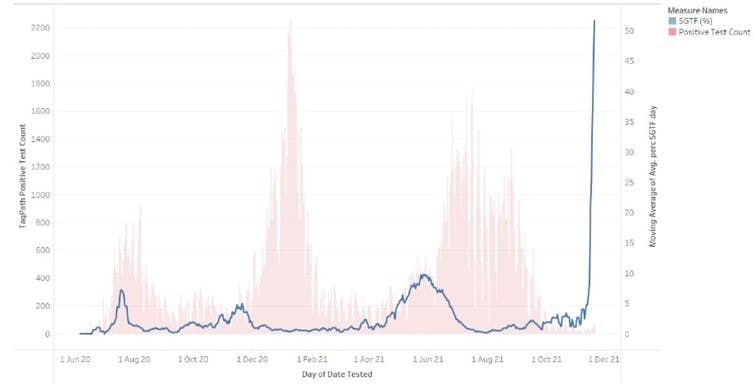The identification of a new variant of SARS-CoV-2 in South Africa, characterized by a large number of mutations (55 in the entire genome, 32 in protein S or spicule) and the vertiginous increase in its relative incidence in that population has skyrocketed once again the alerts on a global scale. Several countries have closed air traffic with South Africa and there are experts who indicate that it is “the most worrying variant we’ve seen to date”. The WHO it has elevated it to the category of “worrying variant” and has designated it with the Greek letter “omicron”.
But, with the available data, can we accept the relevance of these statements? Are they based on demonstrations or are they conjecture? When can we define a new variant as of concern and what consequences does this have on our strategy in the face of the pandemic? I will try in the following paragraphs to shed some light on these issues.
The genomic sequence of the omicron variant (B.1.1.529 lineage in the PANGO system, O Lineage 21K by NextStrain) shows 55 mutations with respect to the original Wuhan virus, 32 of them located in protein S or spicule, the most important due to its role in the infection of cells and the immune response.
Many of these mutations have previously been detected in variants of concern (VOCs) or of interest (VOIs) of the virus, such as the N501Y mutations (present in alpha, beta and gamma VOCs), the T95I, T478K and G142D (all in delta ), or their role has been demonstrated in the interaction with the cellular receptor ACE2 (S477N, Q498R), or they are found in binding regions of some antibodies (G339D, S371L, S373P, S375F).
>
This accumulation of mutations with known effects is already a matter of interest and concern, but adequate experiments have yet to be performed to demonstrate their effects when they are found simultaneously.
The effects of two mutations are not always additive and the interactions (epistasias in technical language) can be both positive (increasing the effect of each one) and negative (decreasing it).
Until we have laboratory results and epidemiological and genomic surveillance data that show us greater transmissibility or greater possibilities of escape from the immune response, it is not reasonable to go from surveillance to alert or, even less, to alarm.
The reason given by the WHO for declaring it as VOC is that it may be associated with an increased risk of infection, although there is still no public information to support this claim.

South African genomic surveillance
However, the red flags have been triggered by the rapid increase in cases detected in South Africa with this variant. It is not strange that a new variant is detected in this country, one of those with the best SARS-CoV-2 genomic surveillance system and in which, as in almost all countries on the African continent, vaccination has not progressed in the same way.
Thanks to their surveillance, the sequence of the virus responsible for a Covid-19 outbreak observed in Gauteng province was quickly obtained, at a time with a very low cumulative incidence of the infection (around 10 cases per 100,000 inhabitants). In these circumstances, any variant associated with an outbreak quickly reaches a high relative frequency, which may indicate greater transmissibility but also that it grows where there was hardly any.
If the main cause for alarm is transmissibility, other properties associated with mutations in the spicule do not leave much room for reassurance, as we have previously indicated. Again we ask ourselves the question of how a virus with so many mutations arises. The answer is not definitive, but the main suspicion is that it has evolved in a patient with a weakened immune system infected over a prolonged period of time, after which it has been transmitted to other people in a chain that is unknown to us for now.

@tuliodna / Centre for Epidemic Response & innovation, South Africa
What can we do in the face of a new worrying variant?
At the moment, we have the same tools as against the others: vaccinate, use masks, maintain distances, ventilate closed rooms, that is, reduce exposure and circulation of the virus to the maximum, increase the immunized population in all countries on the planet, limiting the opportunities for new mutations to appear in the virus.
Although we thought that after the delta variant it would be difficult for variants of concern to appear, the omicron variant has surprised us again. Regardless of whether or not it has the serious consequences that justify its declaration as a VOC, it is clear that the evolution of SARS-CoV-2 may continue to bring surprises. The sooner we reduce those possibilities, the better for everyone.
Fernando Gonzalez Candelas, Professor of Genetics. Head of the Joint Research Unit “Infection and Public Health” FISABIO-Universitat de València I2SysBio. CIBER Epidemiology and Public Health, University of Valencia
This article was originally published on The Conversation. read the original.
Reference-www.eleconomista.com.mx